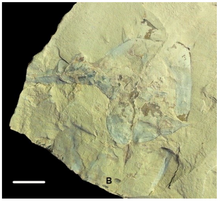| Shenzianyuloma Temporal range: Cambrian Stage 3 PreꞒ Ꞓ O S D C P T J K Pg N | |
|---|---|

| |
| Holotype of Shenzianyuloma yunnanense | |

| |
| Reconstruction with a pointed dorsal fin | |
| Scientific classification | |
| Domain: | Eukaryota |
| Kingdom: | Animalia |
| Phylum: | Chordata |
| Clade?: | †Vetulicolia |
| Genus: | †Shenzianyuloma McMenamin, 2019 |
| Type species | |
| †Shenzianyuloma yunnanense McMenamin, 2019 | |
Shenzianyuloma is an extinct genus of vetulicolian represented by a single species, Shenzianyuloma yunnanense, from the Maotianshan Shale during Stage 3 (518 million years ago) of the Cambrian period. It is notable for having a compact body shape akin to that of an angelfish. It's exact phylogenetic position is unclear, and it was not included in a 2024 phylogenetic analysis of vetulicolians.
Etymology
The name of the genus is derived from the Chinese shénxiān yú (神仙鱼), meaning "angelfish", and an anagram of Mola.
Provenance
The Shenzianyuloma holotype was acquired from a "crystal and fossil vendor" in Lianyungang, Jiangsu, China, and assigned to the Maotianshan shale based on the presence of the brachiopod Diadonga pista on the same slab, as well as the rock's matrix characteristics.
Taxonomy
As of late 2024, Shenzianyuloa has only been discussed in two papers, both published by MDPI, and has not yet been included in any broader phylogenetic analysis such as that done by Mussini et al.
Shenzianyuloma has been interpreted as having a notochord-like structure, as have some other vetulicolians such as Nesonektris and Vetulicola. The recent consensus places vetulicolians as stem-chordates, but their exact position remains unclear. Depending on that position, the presence of a notochord in Shenzianyuloma could either support an ancestral deuterostome with a primitive notochord-like structure, or help resolve the placement of an archaic chordate-related phylum.
References
- ^ McMenamin 2019, p. 11
- ^ Mussini et al. 2024, p. 7
- McMenamin 2019, pp. 20–21
- ^ Sui, Zhao & Dong 2021, p. 3
- García-Bellido et al. 2014, pp. 3–7
Works cited
- García-Bellido, Diego C.; Lee, Michael S. Y.; Edgecombe, Gregory D.; Jago, James B.; Gehling, James G.; Paterson, John R. (2014). "A new vetulicolian from Australia and its bearing on the chordate affinities of an enigmatic Cambrian group". BMC Evolutionary Biology. 14: 214. doi:10.1186/s12862-014-0214-z. PMC 4203957. PMID 25273382.
- McMenamin, Mark A. S. (August 2019). "Cambrian Chordates and Vetulicolians". Geosciences. 9 (8): 354. Bibcode:2019Geosc...9..354M. doi:10.3390/geosciences9080354.
- Mussini, G.; Smith, M. P.; Vinther, J.; Rahman, I. A.; Murdock, D. J. E.; Harper, D. A. T.; Dunn, F. S. (2024). "A new interpretation of Pikaia reveals the origins of the chordate body plan". Current Biology. 34 (13): 2980–2989.e2. doi:10.1016/j.cub.2024.05.026. PMID 38866005.
- Sui, Z.; Zhao, Z.; Dong, B. (2021). "Origin of the Chordate Notochord". Diversity. 13 (10). 462. doi:10.3390/d13100462.
| Taxon identifiers | |
|---|---|
| Shenzianyuloma | |
| Vetulicolia | ||||||||||||||||||||
|---|---|---|---|---|---|---|---|---|---|---|---|---|---|---|---|---|---|---|---|---|
|  | |||||||||||||||||||